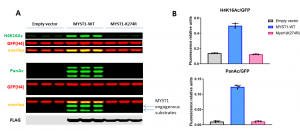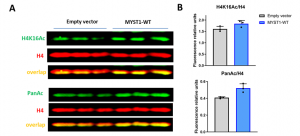Background
The mammalian MYST1 is a member of the MYST family of histone acetyltransferases and is the primary enzyme that catalyzes the acetylation of histone H4 on lysine 16 (H4K16). Acetylation of K16 is a prevalent mark associated with chromatin decondensation. MYST1 has been shown to play an essential role in embryonic formation and development, chromatin assembly, transcription activation, cellular apoptosis, double‐strand break repair, cellular stress response, and tumorigenesis (PMID:24452550, 26387537, 17967868, 24452485).
Assay validation
It was shown that MYST1 participates in at least two distinct multiprotein complexes (MSL and NSL) in human cells. Both complexes can acetylate H4K16; however, the NSL complex possesses broader substrate specificity and can also acetylate histone H4 at K5 and K8 (PMID:26784169). Consistent with previous findings, the overexpression of MYST1 led to an increase in total lysine acetylation levels and acetylation of H4K16 on exogenous (GFP-tagged) as well as endogenous histone H4 (Fig.1 and 2). Due to high basal H4 acetylation levels, only a small increase in acetylation was observed upon MYST1 overexpression in endogenous H4 (Fig.2), making the system with exogenous histone H4 preferential assay for compounds screening. The assay was additionally validated with MYST1 catalytic mutant (K274R), which overexpression in contrast to WT MYST1 did not alter basal exogenous H4 acetylation levels (Fig1).

Fig.1. The wild type but not catalytic mutant of MYST1 acetylated exogenous histone H4. HEK293T cells were co-transfected with GFP-tagged histone H4 and FLAG-tagged MYST1 WT/MutK276R or empty vector for 24 h. A. Western blot analysis of the levels of acetyl-lysine histone H4 (PanAc) and H4K16. B. Quantification of signal intensities of acetyl-lysine histone H4 and H4K16 normalized to GFP. The results are mean +/- SEM of 3 replicates. Antibody detecting acetylated lysine residues showed higher background to noise ratio (Z factor = 0.94) than those detecting H4K16Ac levels (Z factor = 0.91).

Fig.2. MYST1 overexpression slightly increased endogenous histone H4 acetylation. HEK293T cells were transfected with FLAG-tagged MYST1 or empty vector for 24 h. A. Western blot analysis of the levels of acetyl-lysine histone H4 (PanAc) and H4K16. B. Quantification of signal intensities of acetyl-lysine histone H4 and H4K16 normalized to histone H4. The results are mean +/- SEM of 3 replicates.
For assay details, please go to Zenodo.
